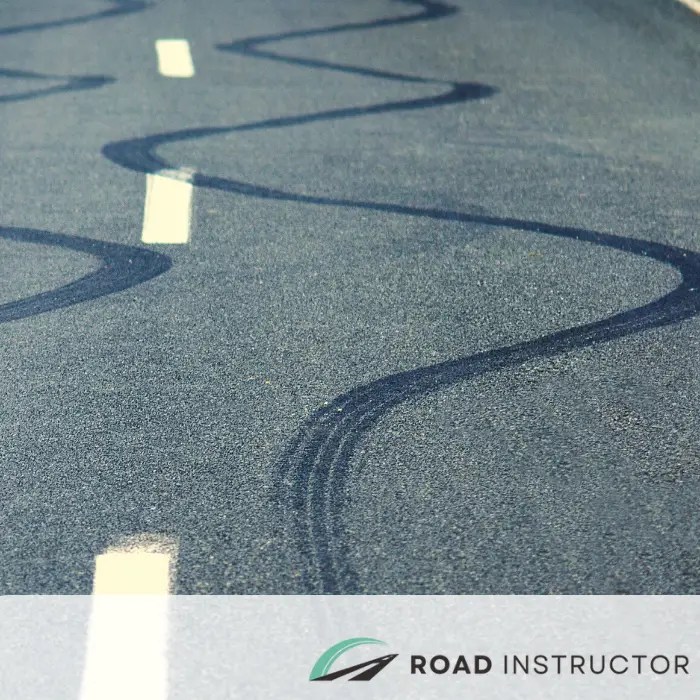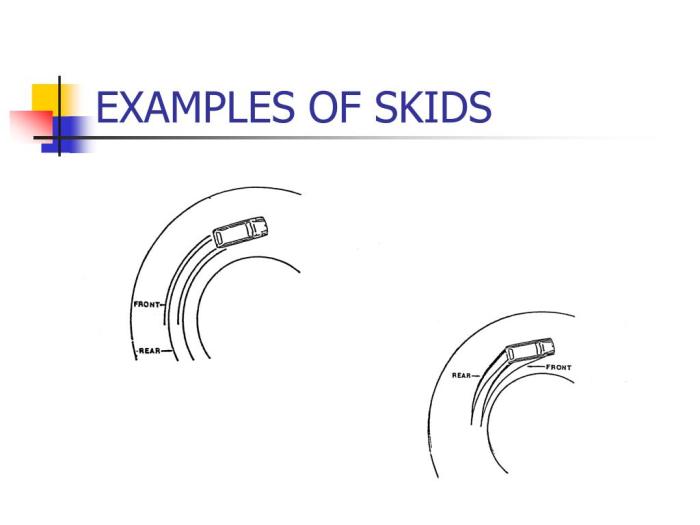Most skids are caused by a combination of factors, including vehicle-related issues, environmental conditions, driver behavior, and vehicle maintenance. Understanding these causes is crucial for preventing skids and ensuring road safety.
This comprehensive guide will delve into the various factors that contribute to skids, providing insights and practical tips to help drivers minimize the risk of skidding and maintain control of their vehicles.
Vehicle-Related Factors

Vehicle-related factors play a significant role in contributing to skids. These include issues with tires, brake systems, and steering systems.
Tire Condition:Tires are crucial for maintaining traction and control on the road. Worn or damaged tires reduce grip, increasing the likelihood of skids. Factors such as tread depth, inflation pressure, and alignment affect tire performance and should be regularly inspected and maintained.
Brake System Malfunctions
- Faulty brake pads or rotors can reduce braking effectiveness, leading to longer stopping distances and potential skids.
- Malfunctioning ABS (Anti-lock Braking System) can prevent wheels from locking up during braking, reducing control and increasing the risk of skids.
- Leaking brake fluid or air in the brake lines can compromise braking performance, potentially causing skids.
Steering System Issues
- Loose or misaligned steering components can affect vehicle stability and handling, making it more difficult to control the vehicle and avoid skids.
- Worn or damaged steering parts, such as tie rods or ball joints, can create excessive play in the steering system, reducing precision and increasing the risk of skids.
- Improper wheel alignment can also contribute to skids by affecting the vehicle’s stability and handling characteristics.
Driver Behavior

Driver behavior significantly influences the likelihood of skidding. Speeding, aggressive driving, and driver inattention or distraction can all contribute to a loss of vehicle control and subsequent skidding.
Speeding
When a vehicle is traveling at high speeds, it has less time to react to changing road conditions or unexpected obstacles. This reduced reaction time can make it difficult for the driver to avoid a skid, especially on slippery or wet roads.
Additionally, speeding increases the centrifugal force acting on the vehicle, which can cause it to lose traction and skid when cornering.
Aggressive Driving
Aggressive driving behaviors such as tailgating, lane switching, and rapid acceleration and deceleration can increase the risk of skidding. Tailgating reduces the following distance between vehicles, leaving less time for the driver to react to a sudden stop or hazard.
Lane switching can be particularly dangerous in wet or icy conditions, as it can cause the vehicle to lose traction when changing lanes. Rapid acceleration and deceleration can also cause the tires to lose traction and skid, especially on slippery surfaces.
Driver Inattention or Distraction
Driver inattention or distraction can significantly increase the risk of skidding. When drivers are not paying attention to the road, they may not notice changing road conditions or potential hazards, which can lead to a loss of vehicle control and a skid.
Distractions such as using a cell phone, texting, eating, or talking to passengers can all take the driver’s attention away from the road and increase the likelihood of skidding.
Vehicle Load and Distribution

The load and distribution of weight in a vehicle significantly impact its handling and stability, affecting its propensity to skid. Overloading or improper weight distribution can disrupt the vehicle’s balance, making it more susceptible to loss of control.
Overloading
- Overloading a vehicle increases the weight it must support, straining its components and reducing its stability.
- The additional weight shifts the vehicle’s center of gravity, making it more likely to tip over during turns or sudden maneuvers.
- Overloading also affects braking performance, as the increased weight requires more force to stop.
Uneven Weight Distribution
Uneven weight distribution occurs when the weight is not evenly distributed across the vehicle’s axles or sides.
- This imbalance can create an uneven load on the tires, affecting their grip and increasing the risk of skidding.
- For example, a vehicle with more weight on one side may have reduced traction on that side, making it more likely to skid when cornering.
Proper Cargo Securing
Properly securing cargo is crucial to prevent skids.
- Loose or unsecured cargo can shift during transit, altering the vehicle’s weight distribution and increasing the risk of skidding.
- Securing cargo securely prevents it from moving and ensures the vehicle’s stability is maintained.
Vehicle Maintenance and Inspection

Regular vehicle maintenance and inspection play a crucial role in preventing skids. By ensuring that critical vehicle components are functioning properly, drivers can minimize the risk of losing control due to skidding.
Tire Maintenance
Tires are the primary contact point between a vehicle and the road surface. Maintaining proper tire inflation, alignment, and tread depth is essential for optimal traction and skid prevention. Underinflated tires increase the contact patch with the road, reducing grip and increasing the likelihood of skids.
Misaligned tires can cause uneven wear, compromising traction and stability. Insufficient tread depth reduces the tire’s ability to channel water and maintain grip, particularly in wet or icy conditions.
Brake System Inspections
A well-functioning brake system is vital for controlling a vehicle’s speed and preventing skids. Regular brake inspections can identify potential issues such as worn brake pads, leaky brake lines, or malfunctioning brake calipers. Worn brake pads reduce the braking power, increasing the stopping distance and the risk of skidding.
Most skids are caused by a loss of traction, which can be due to various factors such as slippery road conditions, worn-out tires, or sudden changes in speed or direction. While these factors can be common causes of skids, it’s interesting to note that tang soo do belt colors also play a role in preventing skids.
Tang soo do is a martial art that emphasizes balance and coordination, and its practitioners often develop excellent control over their bodies. This control can help them maintain traction and avoid skids even in challenging driving conditions.
Leaky brake lines can compromise the brake system’s pressure, affecting its effectiveness. Malfunctioning brake calipers can cause uneven braking, leading to loss of control.
Steering System Maintenance, Most skids are caused by
The steering system allows drivers to control the direction of the vehicle. Regular maintenance ensures that the steering components are in good condition and functioning properly. Worn steering components, such as ball joints, tie rods, or rack and pinion gears, can cause loose or imprecise steering, making it difficult to maintain control of the vehicle, especially in slippery conditions.
Driver Education and Awareness
Driver education programs play a crucial role in equipping drivers with the knowledge and skills necessary to prevent skids. These programs provide comprehensive training on vehicle dynamics, skid prevention techniques, and the importance of safe driving practices.
Public awareness campaigns are equally important in promoting safe driving habits. They can effectively raise awareness about the causes and consequences of skids, and encourage drivers to adopt defensive driving techniques.
Driver Training and Skid Prevention
Driver training programs can significantly improve skid prevention techniques. These programs typically include classroom instruction, hands-on exercises, and simulations that allow drivers to experience and practice skid recovery maneuvers in a controlled environment.
By teaching drivers how to recognize the signs of an impending skid, respond appropriately, and regain control of their vehicles, driver training programs can help reduce the risk of skid-related accidents.
Answers to Common Questions: Most Skids Are Caused By
What are the most common vehicle-related factors that cause skids?
Worn or underinflated tires, malfunctioning brake systems, and steering system issues are the most common vehicle-related factors that contribute to skids.
How do environmental conditions affect the likelihood of skids?
Wet, icy, or uneven road surfaces, as well as rain, snow, or fog, can significantly increase the risk of skids by reducing traction and visibility.
What role does driver behavior play in skidding?
Speeding, aggressive driving, and driver inattention or distraction can all lead to skids by compromising a driver’s ability to react and control the vehicle.